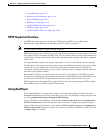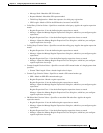
12-22
Cisco ASA Series Firewall ASDM Configuration Guide
Chapter 12 Configuring Inspection for Voice and Video Protocols
SIP Inspection
SIP Instant Messaging
Instant Messaging refers to the transfer of messages between users in near real-time. SIP supports the
Chat feature on Windows XP using Windows Messenger RTC Client version 4.7.0105 only. The
MESSAGE/INFO methods and 202 Accept response are used to support IM as defined in the following
RFCs:
• Session Initiation Protocol (SIP)-Specific Event Notification, RFC 3265
• Session Initiation Protocol (SIP) Extension for Instant Messaging, RFC 3428
MESSAGE/INFO requests can come in at any time after registration/subscription. For example, two
users can be online at any time, but not chat for hours. Therefore, the SIP inspection engine opens
pinholes that time out according to the configured SIP timeout value. This value must be configured at
least five minutes longer than the subscription duration. The subscription duration is defined in the
Contact Expires value and is typically 30 minutes.
Because MESSAGE/INFO requests are typically sent using a dynamically allocated port other than port
5060, they are required to go through the SIP inspection engine.
Note Only the Chat feature is currently supported. Whiteboard, File Transfer, and Application Sharing are not
supported. RTC Client 5.0 is not supported.
SIP inspection translates the SIP text-based messages, recalculates the content length for the SDP
portion of the message, and recalculates the packet length and checksum. It dynamically opens media
connections for ports specified in the SDP portion of the SIP message as address/ports on which the
endpoint should listen.
SIP inspection has a database with indices CALL_ID/FROM/TO from the SIP payload. These indices
identify the call, the source, and the destination. This database contains the media addresses and media
ports found in the SDP media information fields and the media type. There can be multiple media
addresses and ports for a session. The ASA opens RTP/RTCP connections between the two endpoints
using these media addresses/ports.
The well-known port 5060 must be used on the initial call setup (INVITE) message; however, subsequent
messages may not have this port number. The SIP inspection engine opens signaling connection
pinholes, and marks these connections as SIP connections. This is done for the messages to reach the
SIP application and be translated.
As a call is set up, the SIP session is in the “transient” state until the media address and media port is
received from the called endpoint in a Response message indicating the RTP port the called endpoint
listens on. If there is a failure to receive the response messages within one minute, the signaling
connection is torn down.
Once the final handshake is made, the call state is moved to active and the signaling connection remains
until a BYE message is received.
If an inside endpoint initiates a call to an outside endpoint, a media hole is opened to the outside interface
to allow RTP/RTCP UDP packets to flow to the inside endpoint media address and media port specified
in the INVITE message from the inside endpoint. Unsolicited RTP/RTCP UDP packets to an inside
interface does not traverse the ASA, unless the ASA configuration specifically allows it.
Select SIP Map
Add/Edit Service Policy Rule Wizard > Rule Actions > Protocol Inspection Tab > Select SIP Map


















